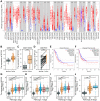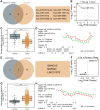SPC25 as a novel therapeutic and prognostic biomarker and its association with glycolysis, ferroptosis and ceRNA in lung adenocarcinoma
- PMID: 38217547
- PMCID: PMC10817414
- DOI: 10.18632/aging.205418
SPC25 as a novel therapeutic and prognostic biomarker and its association with glycolysis, ferroptosis and ceRNA in lung adenocarcinoma
Abstract
Objective: Spindle pole body component 25 (SPC25) is an important cyclin involved in chromosome segregation and spindle dynamics regulation during mitosis. However, the role of SPC25 in lung adenocarcinoma (LAUD) is unclear.
Materials and methods: The differential expression of SPC25 in tumor samples and normal samples was analyzed using TIMER, TCGA, GEO databases, and the correlation between its expression and clinicopathological features and prognosis in LUAD patients. Biological pathways that may be enriched by SPC25 were analyzed using GSEA. In vitro cell experiments were used to evaluate the effect of knocking down SPC25 expression on LUAD cells. Correlation analysis and differential analysis were used to assess the association of SPC25 expression with genes related to cell cycle, glycolysis, and ferroptosis. A ceRNA network involving SPC25 was constructed using multiple database analyses.
Results: SPC25 was highly expressed in LUAD, and its expression level could guide staging and predict prognosis. GSEA found that high expression of SPC25 involved multiple cell cycles and glycolytic pathways. Knocking down SPC25 expression significantly affected the proliferation, migration and apoptosis of LUAD cells. Abnormal SPC25 expression levels can affect cell cycle progression, glycolytic ability and ferroptosis regulation. A ceRNA network containing SPC25, SNHG15/hsa-miR-451a/SPC25, was successfully predicted and constructed.
Conclusions: Our findings reveal the association of up-regulation of SPC25 in LUAD and its expression with clinical features, prognosis prediction, proliferation migration, cell cycle, glycolysis, ferroptosis, and ceRNA networks. Our results indicate that SPC25 can be used as a biomarker in LUAD therapy and a target for therapeutic intervention.
Keywords: SPC25; ceRNA; cell cycle; ferroptosis; glycolysis; lung adenocarcinoma.
Conflict of interest statement
Figures








Similar articles
-
Mechanism Study of E2F8 Activation of SPC25-Mediated Glutamine Metabolism Promoting Immune Escape in Lung Adenocarcinoma.Immunology. 2025 Apr;174(4):450-461. doi: 10.1111/imm.13894. Epub 2025 Jan 19. Immunology. 2025. PMID: 39829079
-
STARD12/14 are diagnostic and prognostic biomarkers of lung adenocarcinoma associated with epigenetic regulation, immune infiltration and ferroptosis.Int J Med Sci. 2023 Sep 11;20(11):1427-1447. doi: 10.7150/ijms.84566. eCollection 2023. Int J Med Sci. 2023. PMID: 37790851 Free PMC article.
-
Bioinformatic prediction of miR-320a as a potential negative regulator of CDGSH iron-sulfur domain 2 (CISD2), involved in lung adenocarcinoma bone metastasis via MYC activation, and associated with tumor immune infiltration.Transl Cancer Res. 2024 Aug 31;13(8):4485-4499. doi: 10.21037/tcr-24-1188. Epub 2024 Aug 27. Transl Cancer Res. 2024. PMID: 39262456 Free PMC article.
-
Regulation of Ferroptosis in Lung Adenocarcinoma.Int J Mol Sci. 2023 Sep 27;24(19):14614. doi: 10.3390/ijms241914614. Int J Mol Sci. 2023. PMID: 37834062 Free PMC article. Review.
-
The multifaceted functions of SPC25 in cancer: from molecular pathways to targeted therapy.Front Med (Lausanne). 2025 May 7;12:1550901. doi: 10.3389/fmed.2025.1550901. eCollection 2025. Front Med (Lausanne). 2025. PMID: 40400636 Free PMC article. Review.
Cited by
-
Berberine restrains non-small cell lung cancer cell growth, invasion and glycolysis via inactivating the SPC25/NUF2 pathway.Naunyn Schmiedebergs Arch Pharmacol. 2025 Jun;398(6):7439-7451. doi: 10.1007/s00210-024-03729-w. Epub 2025 Jan 4. Naunyn Schmiedebergs Arch Pharmacol. 2025. PMID: 39755832
-
SSB expression is associated with metabolic parameters of 18F-FDG PET/CT in lung adenocarcinoma and can improve diagnostic efficiency.Heliyon. 2024 Sep 28;10(22):e38702. doi: 10.1016/j.heliyon.2024.e38702. eCollection 2024 Nov 30. Heliyon. 2024. PMID: 39641036 Free PMC article.
-
Identification and validation of hub genes for kidney renal clear cell carcinoma treated with metformin and everolimus combination therapy.Transl Cancer Res. 2025 Jul 30;14(7):3943-3960. doi: 10.21037/tcr-2025-277. Epub 2025 Jul 24. Transl Cancer Res. 2025. PMID: 40792151 Free PMC article.
-
Omics Integration Uncovers Mechanisms Associated with HIV Viral Load and Potential Therapeutic Insights.medRxiv [Preprint]. 2025 Jul 30:2025.07.29.25332397. doi: 10.1101/2025.07.29.25332397. medRxiv. 2025. PMID: 40766151 Free PMC article. Preprint.
-
Expression patterns of MCM8 in lung adenocarcinoma and its correlation with key biological processes.Eur J Med Res. 2025 Mar 3;30(1):149. doi: 10.1186/s40001-025-02407-8. Eur J Med Res. 2025. PMID: 40033404 Free PMC article.
References
-
- Travis WD, Brambilla E, Nicholson AG, Yatabe Y, Austin JHM, Beasley MB, Chirieac LR, Dacic S, Duhig E, Flieder DB, Geisinger K, Hirsch FR, Ishikawa Y, et al. , and WHO Panel. The 2015 World Health Organization Classification of Lung Tumors: Impact of Genetic, Clinical and Radiologic Advances Since the 2004 Classification. J Thorac Oncol. 2015; 10:1243–60. 10.1097/JTO.0000000000000630 - DOI - PubMed
Publication types
MeSH terms
Substances
LinkOut - more resources
Full Text Sources
Medical
Molecular Biology Databases

